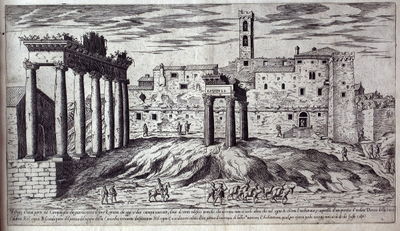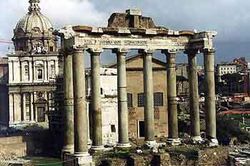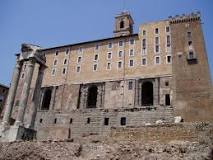Temples: Difference between revisions
No edit summary |
No edit summary |
||
| Line 9: | Line 9: | ||
'''Temple of Saturn''' - Bureau of Vital Statistics. Parents where required to get newborns registered (birth certificate) within 30 days at the Temple of Saturn so that everyone would know when the children reached the age to receive benefits. | '''Temple of Saturn''' - Bureau of Vital Statistics. Parents where required to get newborns registered (birth certificate) within 30 days at the Temple of Saturn so that everyone would know when the children reached the age to receive benefits. | ||
'''The Temple of Venus and Roma''' — in Latin, Templum Veneris et Romae — is thought to have been the largest temple in Ancient Rome. | '''The Temple of Venus and Roma''' — in Latin, Templum Veneris et Romae — is thought to have been the largest temple in Ancient Rome. King Herod also built temple for the same function as His Temple in Jerusalem including King Herod's Temple to Roma and Augustus. | ||
'''Temple of Diana in Ephesus''' - Christians were accused of robbing the Temple of Ephesus. It served as an underwriter for social welfare insurance and a central bank for at least the 127 countries which built the temple. Were Christians actually ''bank robbers''? Or was something lost in translation? Read [http://www.hisholychurch.org/media/books/TKC/TKCi9-2InvestinDiana.php Investing in Diana]. | '''Temple of Diana in Ephesus''' - Christians were accused of robbing the Temple of Ephesus. It served as an underwriter for social welfare insurance and a central bank for at least the 127 countries which built the temple. Were Christians actually ''bank robbers''? Or was something lost in translation? Read [http://www.hisholychurch.org/media/books/TKC/TKCi9-2InvestinDiana.php Investing in Diana]. | ||
| Line 17: | Line 17: | ||
[[Public religion|Public religious]] ceremonies took place outdoors, and not within the temple building. Some ceremonies ended with a temple or shrine, where a ritual object might be stored and brought out for use, or where an offering would be deposited. Sacrifices, like animals, would take place at an open-air altar within the templum and were eaten at festivals or distributed to the poor as a part of the public social welfare in the case of [[Public religion|public religion]]. | [[Public religion|Public religious]] ceremonies took place outdoors, and not within the temple building. Some ceremonies ended with a temple or shrine, where a ritual object might be stored and brought out for use, or where an offering would be deposited. Sacrifices, like animals, would take place at an open-air altar within the templum and were eaten at festivals or distributed to the poor as a part of the public social welfare in the case of [[Public religion|public religion]]. | ||
The real Church established by Christ must be the temple of [[Pure Religion]]. The ''temple of God'' is made of living stones who care about one another in the love of Christ. They function through charity while the Temples of the world force the contributions of the people under the authority of men like Cain and [[Audio-Video#Nimrod_to_Now_Series|Nimrod]]. | The real Church established by Christ must be the temple of [[Pure Religion]]. The ''temple of God'' is made of living stones who care about one another in the love of Christ. They function through charity while the Temples of the world force the contributions of the people under the authority of men like Cain and [[Audio-Video#Nimrod_to_Now_Series|Nimrod]]. | ||
Revision as of 08:56, 16 September 2014
Can the Church be a temple or a temple a Church?
The English word "temple" derives from Latin templum, which was originally not the building itself, but a sacred space surveyed and plotted ritually. Today we associate a temple with the buildings that have survived through history. What were their real purpose? Are other buildings like the temples such as government buildings who serve the public's welfare?
What were they doing in what we call pagan temples?

Temple of Nebo - Parents sent their children to the Temple of Nebo to receive their public education. Nebo was the Mesopotamian god of education, wisdom and oracles.
Temple of Saturn - Bureau of Vital Statistics. Parents where required to get newborns registered (birth certificate) within 30 days at the Temple of Saturn so that everyone would know when the children reached the age to receive benefits.
The Temple of Venus and Roma — in Latin, Templum Veneris et Romae — is thought to have been the largest temple in Ancient Rome. King Herod also built temple for the same function as His Temple in Jerusalem including King Herod's Temple to Roma and Augustus.
Temple of Diana in Ephesus - Christians were accused of robbing the Temple of Ephesus. It served as an underwriter for social welfare insurance and a central bank for at least the 127 countries which built the temple. Were Christians actually bank robbers? Or was something lost in translation? Read Investing in Diana.
Temples were places where public religion and worship occurred but to understand what that means you must understand what Religion was supposed to be.
Public religious ceremonies took place outdoors, and not within the temple building. Some ceremonies ended with a temple or shrine, where a ritual object might be stored and brought out for use, or where an offering would be deposited. Sacrifices, like animals, would take place at an open-air altar within the templum and were eaten at festivals or distributed to the poor as a part of the public social welfare in the case of public religion.
The real Church established by Christ must be the temple of Pure Religion. The temple of God is made of living stones who care about one another in the love of Christ. They function through charity while the Temples of the world force the contributions of the people under the authority of men like Cain and Nimrod.

The Christian conflict with the people who persecuted them in the early days of the Church was mostly over their system of social welfare which was managed through their temples like Ephesus, Temple of Saturn and the Parthenon.
Romans had superstitions but they were practical people. They did not build without a purpose an a plan. Saturn was the god of agriculture. Agriculture needs calendars and records.
Eventually when the Roman State became the Benefactors of the people through its systems of welfare parents where required to register newborns (birth certificate) within 30 days at the Temple of Saturn so that everyone would know when the children reached the age to receive benefits.

The first building for maintaining public records in Rome, including the law, was erected under the protection of the temple of Saturn, as early as 509 B.C. but was possibly burned by the Gauls in 309 B.C. Other buildings were used until 78 B.C. when they built the great Tabularium, on Capitoline Hill, below the Temple of Jupiter, which was the symbol of the sovereignty and power of Rome.
Jewish Temples
Temple of Herod - Those baptized into Herod's government went to Herod's temple to receive welfare and social security benefits. More on the two types of baptism.
LISHKAS HAGAZIS
Lishkas Hagazis was known as the Chamber of Hewn Stone It was the top of the Jewish legal system. It was their supreme court building. Here the Sanhedrin, seventy-one judges met. They dealt with the more difficult cases and was the court of final appeal in all matters of Jewish law. They also gave the final approval for a Jewish king to go to war, oversaw the function of the Temple and of course the temple was a government building.
Also read more on how Christians weren't registered in central government of the day.
The Christians depended on a Holy temple made of living stones which was a network of people living by the perfect law of liberty and faith, hope and charity. Those that had shared with those who had true needs.
Religion |
Pure Religion |
Private welfare |
Fleeing Religion |
False religion |
Public religion |
Our Religion |
Christian conflict |
Corban |
Baptism |
Benefactors |
That Word |
Daily ministration |
Modern Christians |
Diocletianic Persecution |
Christians check list |
gods |
Judge not |
Judge |
Fathers |
Deist |
Damnable heresies |
Factions at the altar |
Pharisees |
Sadducees |
Zealot |
Essenes |
Levites |
Messianic Judaism |
Menahem the Essene |
Sanhedrin |
Altars |
Clay and Stone |
Red Heifer |
Golden calf |
Freewill offerings |
Religion |
Pure Religion |
Public religion |
Christian conflict |
Paganism |
Denominations |
Dispensationalism |
Benefactors |
Corban |
Daily ministration |
Calendars |
Cult |
Imperial Cult of Rome |
Guru theories| |
Covet |
Merchandise |
Mark of God |
Mark of Cain |
Mark of the Beast |
Nature of the Beast
Section 666 |
Benefactors |
Biting one another |
Cry out |
Worship |
Church |
Temples |
Religious Orders |
Priests |
Kings and priests |
Hear |
Bible Index |
Network |
Economy |
Spiritual Economics |
Capitalism |
Socialism |
Divers lusts |
Business |
Kingdom Business |
Welfare |
Surety |
Temples |
Temple of Diana |
Temple in Jerusalem |
Seven Men |
Money Audio |
Real Money |
Money can be anything |
Debt Money |
Money as debt quotes |
Bitcoin |
Cashless |
Money |
I paid in |
Commodity money |
Value |
Mammon |
Covet |
Merchandise |
One purse |
Road Map |
Golden calf |
Temples |
Treasury |
Moneychangers |
The Bank of the Golden Calf | Study audio
Seven men |
Reserve fund |
Ephesus |
Tithe |
Sabbath |
Credit unions |
Thy first love |
HHC Money vs Mammon >
>Audio |
Conversion vs Reconversion >
>Audio |
See more Forbidden Definitions